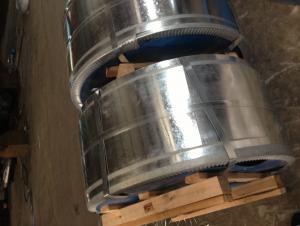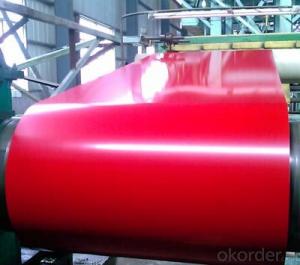Cold Rolled Galvanized Steel Strip Coils Q195 Q235 in China
- Loading Port:
- Qingdao
- Payment Terms:
- TT OR LC
- Min Order Qty:
- 44 m.t.
- Supply Capability:
- 22232332 m.t./month
OKorder Service Pledge
OKorder Financial Service
You Might Also Like
Specification
Applications of Steel Strip Coils:
1:Chemical industry equipment, Industrial tanks
2:Medical Instruments,Tableware, Kitchen utensil,kitchen ware
3:Architectural purpose, Milk & Food processing facilities
4:Hospital Equipment, interior Exterior decoration for building
5:Architectural purposes, escalators, kitchen ware,vehicles
Festures of Steel Strip Coils:
1. Each coil is closely covered by oil paper or plastic film.
2. Outside it is firmly packed with sack cloth or compound paper.
3. Steel strap or PP strap to pack the outside to ensure safety.
4. On/about 1000kgs to be packed with one wooden pallet.
5. Strips can be loaded to 20'FCL without pallet if required by customer.
6. LCL shipment can also be arranged once required by the customer.
Specifications of Steel Strip Coils:
| Standard | Galvanized Steel Coil Grade | Zinc Coating | Width | Thickness | Length | Capacity/Year |
| JIS G3302 | SGCH/SGCC-SGC570/SGHC-SGH340 | Z40-275g | 30-914mm | 0.3-4.0mm | Coil | 1,00,000Ton |
| EN 10346 | DX51D+Z/DX53D+Z/S220GD-S550GD | Z40-275g | 30-914mm | 0.3-4.0mm | Coil | 1,00,000Ton |
| ASTM A653 | CS-B/SS255-550 | Z40-275g | 30-914mm | 0.3-4.0mm | Coil | 1,00,000Ton |
Images of Steel Strip Coils:

FAQ
1.What's your MOQ?
25MT, it is for one container.
2.Do you have QC teams?
Yeah, sure, our QC team is very important, they will keep the quality control for our products.
3. What's your normal delivery time?
Our delivery time about 10-20days for standard sizes, if you have other requirements like hardness and width ,it is about 20-40days.
- Q: How are steel strips inspected for internal defects?
- Various non-destructive testing methods are employed to inspect steel strips for internal defects. Ultrasonic testing is a common technique whereby high-frequency sound waves are transmitted through the steel strip. If there are any internal defects such as cracks, voids, or inclusions, the sound waves will be reflected differently, enabling sensors to detect these reflections. By analyzing the reflection pattern, the size, shape, and location of the internal defects can be determined. Another method utilized is magnetic particle inspection. This technique involves magnetizing the steel strip and applying iron particles onto its surface. Internal defects disrupt the magnetic field within the strip, causing the iron particles to cluster around them. This clustering can be visually observed and indicates the presence of internal defects. Liquid penetrant testing is also utilized to inspect steel strips for internal defects. This process entails applying a liquid dye penetrant to the strip's surface. The dye permeates any surface openings, such as cracks or voids, and is allowed to dwell for a specific period. Afterward, the excess dye is removed, and a developer is applied. The developer draws the remaining dye out of the defects, making them visible and easily detectable under appropriate lighting conditions. Furthermore, eddy current testing can be employed to inspect steel strips for internal defects. This method involves passing an alternating current through a coil, generating an electromagnetic field. As the coil is moved along the strip's surface, sensors detect any variations in the electromagnetic field caused by internal defects. These variations are then analyzed to identify the presence and characteristics of internal defects. In summary, these non-destructive testing methods offer reliable and efficient means of inspecting steel strips for internal defects without causing any harm to the material. They play a crucial role in ensuring the quality and integrity of steel strips before their use in various applications.
- Q: What are the weight considerations for steel strips?
- Weight considerations for steel strips primarily depend on the intended application and the specific requirements of the project. Factors such as the thickness, width, and length of the steel strip, as well as the type and grade of steel used, determine its weight. Additionally, the weight of steel strips can impact transportation, handling, and installation processes. Therefore, it is crucial to carefully consider weight specifications to ensure efficient and safe use of steel strips in various industries like construction, manufacturing, or automotive sectors.
- Q: How are steel strips used in the production of consumer electronics?
- Steel strips are used in the production of consumer electronics to provide structural support and enhance durability. They are often used as casing or reinforcement materials for electronic devices, ensuring the strength and stability of the product.
- Q: Can steel strips be used in the manufacturing of hand tools?
- Yes, steel strips can be used in the manufacturing of hand tools. Steel is a commonly used material in the manufacturing industry due to its strength, durability, and resistance to wear and tear. Steel strips can be cut and shaped into various components of hand tools such as blades, handles, and sockets. Additionally, steel can be heat-treated to enhance its hardness and strength, making it ideal for tools that require sharp cutting edges or heavy-duty usage. Overall, steel strips are a versatile and reliable material that can be effectively utilized in the manufacturing of hand tools.
- Q: Can steel strips be used in the production of railway tracks?
- Yes, steel strips can be used in the production of railway tracks.
- Q: What are the common flatness tolerances for steel strips?
- The common flatness tolerances for steel strips typically range from 0.003 to 0.010 inches, depending on the specific application and industry standards.
- Q: Can steel strips be used in marine or offshore applications?
- Yes, steel strips can be used in marine or offshore applications. Steel is a durable and strong material that can withstand harsh marine environments, such as saltwater exposure and corrosion. Additionally, steel strips can be shaped and formed to meet the specific requirements of marine or offshore structures, making them a suitable choice for these applications.
- Q: How do steel strips contribute to weight reduction in various applications?
- Steel strips contribute to weight reduction in various applications by being lightweight yet strong. They provide a high strength-to-weight ratio, allowing manufacturers to use thinner and lighter steel strips without sacrificing structural integrity or performance. This reduction in weight can lead to improved fuel efficiency in transportation, increased payload capacity in aerospace, and overall cost savings in various industries.
- Q: What are the factors that affect the machinability of steel strips?
- There are several factors that can affect the machinability of steel strips. 1. Chemical composition: The composition of the steel, including the presence of alloying elements, can greatly impact its machinability. Elements such as sulfur, phosphorus, and lead can improve machinability, while others like chromium and nickel can decrease it. 2. Hardness: The hardness of the steel strip is another crucial factor. Harder steels tend to be more difficult to machine, as they require more cutting force and can lead to higher tool wear. 3. Microstructure: The microstructure of the steel, including factors such as grain size and distribution, can affect machinability. Fine-grained steels generally have better machinability compared to coarse-grained ones. 4. Heat treatment: The heat treatment process used on the steel strip can significantly impact its machinability. Improper heat treatment can result in increased hardness or internal stresses, making machining more challenging. 5. Cutting conditions: The speed, feed rate, and depth of cut during machining operations also play a critical role in machinability. Proper cutting conditions must be selected to ensure efficient material removal and avoid excessive tool wear. 6. Tool material and geometry: The type of cutting tool used, as well as its material and geometry, can influence machinability. Tools with appropriate hardness, coatings, and cutting edge angles must be selected to optimize the machining process. 7. Lubrication and cooling: The use of appropriate lubricants and coolants during machining operations can enhance machinability. They help reduce friction and heat generation, improving surface finish and tool life. 8. Machine rigidity: The rigidity and stability of the machine used for machining steel strips are crucial factors. Machines with higher rigidity can provide better stability, resulting in improved machinability. Overall, a combination of these factors and their proper consideration is essential to achieve optimal machinability when working with steel strips.
- Q: Can steel strips be used for making automotive components?
- Yes, steel strips can be used for making automotive components. Steel strips are often used in the automotive industry for various applications such as manufacturing chassis, body panels, reinforcement parts, and structural components. The high strength and durability of steel make it an ideal material for automotive applications, providing the necessary strength and safety required for automotive components. Additionally, steel strips can be easily formed and fabricated to meet the specific design requirements of automotive parts.
Send your message to us
Cold Rolled Galvanized Steel Strip Coils Q195 Q235 in China
- Loading Port:
- Qingdao
- Payment Terms:
- TT OR LC
- Min Order Qty:
- 44 m.t.
- Supply Capability:
- 22232332 m.t./month
OKorder Service Pledge
OKorder Financial Service
Similar products
Hot products
Hot Searches
Related keywords



























